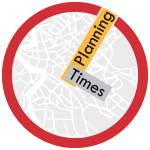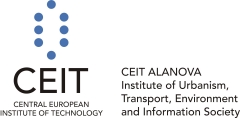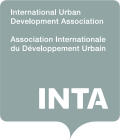|
PLANNING TIMES
PLANNING TIMES
Come gather ’round planners
Wherever you plan
And admit that your plans
Around you have grown
And accept it that soon
You’ll be planning a-new
If your job to you
Is worth savin’
Then you better keep plannin’
Or you'll get in deep water
For the cities they are a-changin’ ...
The relationship between space and time has been formulated in the most diverse planning theories and has fascinated mankind from the beginning. When planning our cities, when defining projects that may improve the conditions of our society, when proposing decision processes that manage the space around us, when implementing techniques to foster development - the relationship between space and time is something we are constantly working with.
In May 2013, REAL CORP explored the relationship between time and space, and how the planning practise and theory relates itself to this complex synergy.
Time and space work on different scales, dimensions and topics – and confront us with questions such as:
- How to plan taking into account time, both past history and future development?
- How to integrate monitoring within the planning decision processes, such as in the case of natural disasters?
- How to handle time that cannot be planned, such as long decision processes or real time decisions?
REAL CORP 2013 in Rome will be an occasion to discuss about theories and methods but also hands-on experiences from all over to world on how planning deals with space in time in order to plan our cities and regions.
The time has come! Send your contribution to the following categories:
1. Environment and Spaces over Time
1.1 Fragile Cities
- How can planning improve cities’ resilience to natural disasters?
- In the past years, natural disasters have affected many cities with different cultural and economic situations.
- How can cities be prepared to tackle this?
1.2 Environmentally Smart Communities and Regions
- How resources are managed between community planning and new technologies
- Worldwide the need to better handle our resources has been recognised via the use of policies and guidelines.
- How are these translated into cities?
- How do citizens use technologies in their everyday life to improve the urban environment?
1.3 Governing Networks across Borders
- How to manage natural elements and infrastructures that do not respect boundaries and national borders?
- From trans-national to municipal scale there seems to be the need to coordinate various actors involved in the management of networks such as natural elements (rivers, natural corridors, etc.) or infrastructures (water, roads, etc.) across borders and boundaries.
- What structures and what modalities are being developed to do this?
2. Slow or Fast Economy
2.1 Creative Competitive Territories
- How can Regional and Metropolitan planning improve territorial competitiveness and cohesion?
- In times of economic-financial crisis, how can green economy, flexible specialisation of regions, creative industries, etc. is combined with de-growth models of development, shrinking cities, etc?
2.2 Discomfort of the Present, Relief of the Future
Cities are the main producers of economic activities, but what are the means to achieve this in the Balkans and the Mediterraneum? Cities in the 21st century face the challenge of being competitive and maintaining a reasonable state of welfare at the same time. Many cities in EU neighbouring countries (especially in Balkan and Mediterranean areas) have a significant urban development deficit in terms of integrated strategies, capacity and urban implementation tools. Tackling the problem of incoherent urban and regional development is a challenge of present days ... and an opportunity for shaping vision for the future.
2.3 Economy out of the Big Lights
- How to boost economy in areas outside of the main cities?
- 50 % of world’s population is now living in cities, yet the other half is not and is distributed on a far larger surface.
- What new economic trends are occurring in not highly urbanised areas around the globe? What are the strong points they are strengthening and what are their challenges?
3. Timing Society
3.1 Social Housing: Yesterday, Today ... and Tomorrow?
- The affordable housing demand is becoming an emergency even in cities with a weak demographic growth. What are cities round the globe doing to tackle these issues?
- What are best and worst practices of urban regeneration around the world that promoted housing and slum upgrading?
3.2 Cities for All
- How cities can be inclusive?
- Inclusion of citizens in today’s society means taking into account the variety of people that live in our cities. The diversity of citizens ranges from age, physical disabilities but also foreign background and cultural differences.
- On the one hand cities need ad hoc strategies for each user group and on the other there is the need for a holistic vision for an inclusive city. How can cities accommodate the society of today and tomorrow?
3.3 Improving Daily Resilience of our Communities
Ensuring consistent standards of quality of life within a continuously changing urban context – Resilience is usually considered in the context of large-scale man-made or natural accidents. However cities are continuously changing ecosystems where small daily events require new smarter mobility concepts. These need to be capable to maximise real-time information coming from the community in order to deliver personalised solutions that can support our communities at large. How technology can support communities improve resilience to unplanned situations?
4. Moving a Tempo
4.1 Real Time Planning
- Do the right thing when time tends to zero
- Decision making and planning processes take relatively long time before becoming effective, so what happens when decisions need to be immediate?
- Are there cases where decisions on cities are taken out of the traditional planning framework?
- And what are the technologies that enable this?
4.2 Memory and Imagination
- How cultural heritage can be integrated in today’s city
- Some cities more than others have a great cultural heritage that also becomes an attractor for tourism, but how can this not become a limit towards contemporary living?
4.3 Changing at Fast Pace
- Smart platforms to cope with a fast-evolving city
- While in the past changes required decades or centuries to occur, cities are now very dynamical systems of systems where transportations, energy, communication networks have to fast adapt to ever changing conditions. Smarter energy grids need to react to fast changing production or consumption regimes, communication network need to be able to adapt to varying traffic conditions.
- Which are the tools that can be used to keep up with such a fast evolution?
5. As Time goes by ... Never-Ending (Under) Development Stories
5.1 Cities have Never been Modern!
- What are the new combination of factors which lies behind the unending change of present-day “invisible cities”?
- Modernity does not unfold equally at the core and at the periphery of world systems. Where power and money concentrate, the logic of development seems easier to retrieve. Elsewhere, development and modernity seem to lose some of their features.
5.2 Lost in Spaces ...
- Does lost space generate processes of social construction and does it shape the urban fabric?
- Planning tools and policies determine the multidimensional network that regulates the exchange of information flows. The lack of civic aggregation in public space, of construction of collective and participatory spaces opens the doors to “the lost space”.
5.3 As You Change, You Still Remain the Same
- In the life of buildings and neighbourhoods changes develop a new face of the surroundings.
- Brownfield development, new functions of buildings and gentrification are processes that occur all over the world, but what are the differences and similarities?
- How is the experience from best and worse practises being capitalised?
6. Planners' toys – Data, Tools and Gadgets
6.1 Data and Information Infrastructures – the Essential Fuel to Power Planning Processes
6.2 Visioning, Simulation, Decision Support and Scenario Tools
What are the key features of modern or future strategies, concepts, approaches, methods and technologies that are implemented in planning tools and can meet the challenges of managing urban time and space?
Global projects and specialized tools for playing with models and virtual reality are cornerstones inside a computer’s work space of planners. IGIS technologies, data fusion, modelling, simulation and scenario tools; 2D, 3D, 4D visualization and visioning solutions for augmented and mixed realities are essential components for planners. Examples of applied tools versus design, architecture and implementation aspects will be discussed.
Monitoring and decision making support systems for urban planning intended for local, regional and global scales form basic capabilities for solving many practical problems.
6.3 Real Time, Real Space, Real Life?
“For if there are times past and future, I desire to know where they are.” (Augustine, Confessions XI.18)
|



























